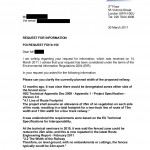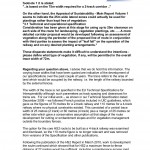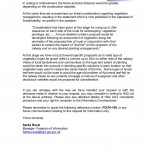Last October, we produced a short leaflet which said “The 72 metres ‘no vegetation’ width is wider than Wembley (69 metres).”
“No vegetation” was the phrase used in one of the documents put out by HS2 Ltd in March 2010. You can download it from here.
Page 12 of the document, which has the compelling title of “High Speed Rail London to the West Midlands and Beyond HS2 Technical Appendix”, says
“The project shall assume an allowance of 25m of no vegetation on each side of the route, resulting in a total footprint for a two-track line of route of 75m width and 110m width for a four track railway.
“Where space is restricted, the minimum two-track fence to fence width may be reduced from 25m to 15m. This reduction shall only be accepted exceptionally for short distances where no other solution is viable. The corridor width of 25m should be retained to allow for the inclusion of access tracks etc.”
At the technical seminars held by HS2 Ltd in 2010, attendees were told that the fenced zone could be reduced to 22m wide (from 25m) and we allowed for that when writing our leaflet.
Seeking the most uptodate information he could, earlier this year, one of our supporters issued a FOI request and got the following letter back:
- p1
- p2
- p3
- p4
Pulling out a paragraph from p3
“At this stage we have not put forward specific proposals as to what type of vegetation might be grown within a corridor up to 25m on either side of the railway. Views of local landowners and communities on the type and extent of planting would be taken into account in deciding specific solutions in each location so that vegetation was used to reduce the visual impact of the line. Some types of broad leaf tree would not be used to avoid the age-old problem of Autumnal leaf-fall on the railway tracks so we currently envisage a mixture of evergreen and other deciduous varieties would be proposed for consideration.”
So in March this year, HS2 Ltd were saying the landtake is still wider then Wembley along much of the route, but nobody knows where it will be less.
And if you want the most up-to-date view of HS2, you can see what Alison Munro, Chief Executive of HS2 Ltd had to say last week, in a letter published in the Bucks Free Press:
“We would therefore seek to manage woody vegetation on the land up to 25 metres on either side of the line.”
So in June 2011 the latest information from HS2 Ltd is that the landtake will still be up to 72m – or wider then Wembley.





Luke, your enthusiasm for Maglev is impressive and I look forward to seeing you levitate, magnetically or otherwise.
There are, however, major objections to building Maglev lines instead of conventional railways.
Britain already has ,despite Beeching, a widespreading network of railways. Schemes such as HS1 and HS2, the alternative RP2, the French TGV, the German ICE, the Spanish AVE; allcan or do connect with existing routes and routes. They are in effect, Bypasses to congested sections or ,like the new tunnels through the Alps, built to avoid the inherited limitations of 19th century engineering.(much of the WCML comes within this category)
Like their highway and motorway counterparts, these “bypass” railways can integrate with the existing network. Maglev, being a distinct and incompatable system cannot connect and integrate. So unless you are advocating converting every track and depot, every branch and station to Maglev, (whichever of the several versions might be chosen,) surely it can only be of use in a limited application ,such as a new separate city centre- airport link .
The other immediate objection is cost. While several experimental tracks have been built, the cost,apparently twice that of a conventional High Speed line ,prevents a general adoption of Maglev.
If people hesitate(!) at a £17Billion price tag for HS2 stage one, how would you sell the idea of doubling that figure for a system which couldn’t join up ?
During my recent travel up to the Lake District, our train was late because of speed restriction due to an overheated section of the track, which I have never heard of before.
So if HS2 travels at much higher speeds of 250mph, won’t that surely produce more heat on the track?
Planting of evergreen may save us all from the immortal problem of leaves on the line, but what about heat from the track? and not forgetting those pesky overhead cables.
Needles too say, Maglev suffers from none of these problems and is much more environmentally friendly, take a look at the comparative data – http://www.500kmh.biz/UltraspeedMedia/Latest_News/Entries/2010/5/19_Entry_1.html
i really really think that this subject has been covered to exhaustion now. the tracks themselves are 22 metres wide that is the most important measurement. look at hs1 where it crosses countryside. the green stuff between the fence and the running lines is called vegetation. similar to what fills the middle of wembley stadium !
i think we can safely say that by no vegetation they mean trees or maybe certain types of larger bushes. trees can fall on the line and falling leaves cause traction problems. similarly you wouldnt want anything with large roots to close enough to the lines
what you are trying to do is implant a vision in peoples minds of a 75 metre wide concrete strip in a desolate wasteland where nothing can survive ! we know that there will be greenery of some kind. and you always use wembley stadium as the comparison – why not something else that is similar like maybe hs1 or say as wide as two football pitches. the reason is because it conjures up visions of huge concrete stadiums all the way along hs2.
tracks can buckle in very hot conditions or i suppose a dragging wheel or axle could heat the track but wouldnt think it was likely. never heard of overheating on high speed rails though despite the enormous friction generated.
re maglev – would this be built at ground level or in a trench or on a huge concrete viaduct ? and what about noise levels would think they would be at least as much as hs2.
Ok ….lets have a proper look at this using the wonders of modern technology. I ve just used Google Maps to find an area of WCML which has similar charecteristics to the Chilterns. I ve settled on a stretch just north of Tring.
There is a road bridge crossing the line called the B488 ( Upper Icknield Way in Buckinghamshire ) . If you zoom in on this bridge and the plonk yourself on it using the eye level street view icon, it gives you a pretty good idea of what HS2 will look like in the raw. if you look north over the bridge parapet, the line is in cutting. This is four track rail so the land take wont be quite as dramatic, but none the less, I ve just estimated that fence to fence on top of the cutting is about 80 metres. The embankments are of course green, but in reality are of no practical use to farmers or ramblers etc. If you were stood in the field to the left of the cutting, you wouldnt actually see the line at all, so no line of sight issues if there were homes built there. Noise would not be anything like it would be if the line was at ground level, and of course if it was at ground level, then it would be highly visible.
Notice the mobile phone mast next to the line – this is virtually brand new. What a lot of stopHS2 campaigners are not aware of is the fact that Network Rail are putting a lot of these up right now as part of the new GSM-R comms project in order to improve communication up and down the network…..in effect wireless technology for the rail industry. We would expect HS2 to be state of the art, and would expect this sort of comms device to be prevelant…..the less cable the better.
A mixture of all three. Only not a viaduct, a monorail which is smaller.
But it would take up less land, only 2m squared for the monorail struts, combine harvests, cattle, etc, can pass underneath, that what happens it Emsland in Germany already, and the cattle are unaffected by the noise.
It would be safer too because the train is magnetised to the track, it cannot derail, also no level crossings would be needed as the monorail can simply go over the top of the road, so there is no chance of a car or anyone walking onto the track.
The loud noise given off by trains as they pass by are the sounds of steel wheels grinding on steel rails. Maglev trains don’t have wheels, and they don’t produce any friction, they levitate, or fly.
Maglev trains do produce whooshing noises as the air passes by, but the noise level is far less then that produced by HSR.
And the BCR for building a maglev line identical to HS2 is ?
I have to say that I don’t know the benefit-cost-ratio as I am just someone who is interested in it, I have not done to studies into it.
But Maglev is similar to HSR, just 100mph quicker, so we can predict the benefit would be more.
HS2 isn’t really that big, stage one is a single line, stage two is 2 additional lines (in the Y), so for the same amount of cost, a much bigger Maglev network could be built.
If you care to read the Maglev study done by UK Ultraspeed http://www.500kmh.com/UKU_Factbook2.pdf and http://files.me.com/alan_james/w9efx3
You can see that the two stages of the Maglev study show for a complete national network, whilst HS2’s two stages only make it as far as Leeds, it could be another 30 years or more before it reaches Scotland.
HS2 Ltd hasn’t released any data yet for stage two, so we will have to go with the study by UK Ultraspeed.
A HSR TGV-style train could reach Manchester in 104 with 0 stops, saving, 23mins, while Transrapid Maglev can get there in 74mins with 7 stops, saving 53mins, or in 54 minutes with 2 stops, saving 73 mins.
So if you go with “time is money”, or the more stop, the more people can get on, and thus more economic growth in those cities in which the train stop – Maglev wins on both accounts.
30min to Birmingham airport, 53mins to Manchester airport, would bring them closer than many stations on the London underground, so it would be hugely beneficial.
So it will have more benefit, and less costs, long term maintenance costs are the most important remember, and Maglev in virtually free from any.
I don’t think people understand what a big risk and commitment HS2 is and will be, a network all the way up to Scotland will take several decades to construct, and once it’s stated there’s no turning back.
The guideways for Maglev, on the other hand, can all be pre-fabricated off site, so it won’t take nearly as long to construct.
I think HS2 would be a terrible mistake, and I genuinely don’t understand why Maglev has been ignored, the white paper brought out by the Labour govt whitewashes the technology, and a letter from HS2 Ltd showed that they did not understand the science.